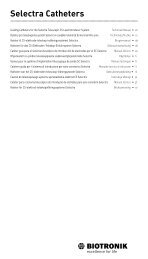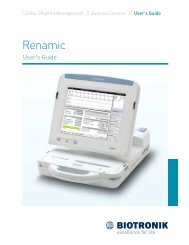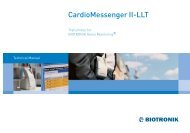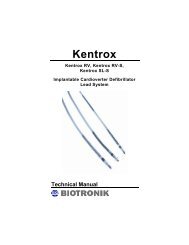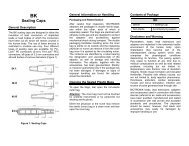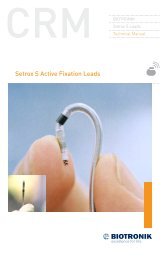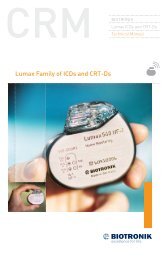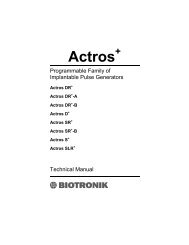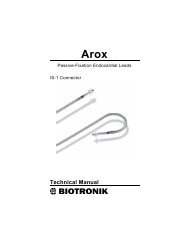Estella Pulse Generators - BIOTRONIK USA - News
Estella Pulse Generators - BIOTRONIK USA - News
Estella Pulse Generators - BIOTRONIK USA - News
Create successful ePaper yourself
Turn your PDF publications into a flip-book with our unique Google optimized e-Paper software.
<strong>Estella</strong> <strong>Pulse</strong> <strong>Generators</strong> Technical Manual 61WarningUnipolar/Bipolar—All <strong>Estella</strong> models can be used witheither unipolar or bipolar IS‐1 leads.7.7 Parameters for Rate-Adaptive PacingThe <strong>Estella</strong> pulse generator achieves rate adaption through programmingstandard motion-based pacing via a capacitive accelerometer.For standard motion-based rate adaption, the pulse generator isequipped with an accelerometer located on the hybrid circuit of thepulse generator. This sensor produces an electric signal during physicalactivity of the patient. If a rate-adaptive mode is programmed, thenthe sensor signal controls the stimulation rate. Sensing and inhibitionremains in effect during sensor controlled operation. In the case of highpacing rates, however, the refractory periods may cover a majority of thelower rate interval, resulting in asynchronous operation.For a complete list of rate-adaptive pacing modes available in the<strong>Estella</strong>, see Section 15.1.The following functions are available for tailoring the motion based rateadaptation to the individual patient.7.7.1 Sensor GainThe sensor gain defines the slope of the linear function betweenexertion and pacing rate. It designates a factor by which the electricsignal of the sensor is amplified prior to the signal processing stages.The programmable amplification permits adaptation of the individuallyprogrammed sensor gain to the desired rate response. The optimumsetting is achieved when the desired maximum pacing rate duringexertion is reached during maximum exercise levels. The rate increase,rate decrease and maximum sensor rate settings must be checked fortheir suitability with respect to the individual patient before adjustingthe sensor gain.If the sensor-driven rate is not sufficient at high levels of exertion thesensor gain setting should be increased. The sensor gain should bereduced if high pacing rates are obtained at low levels of exertion.



